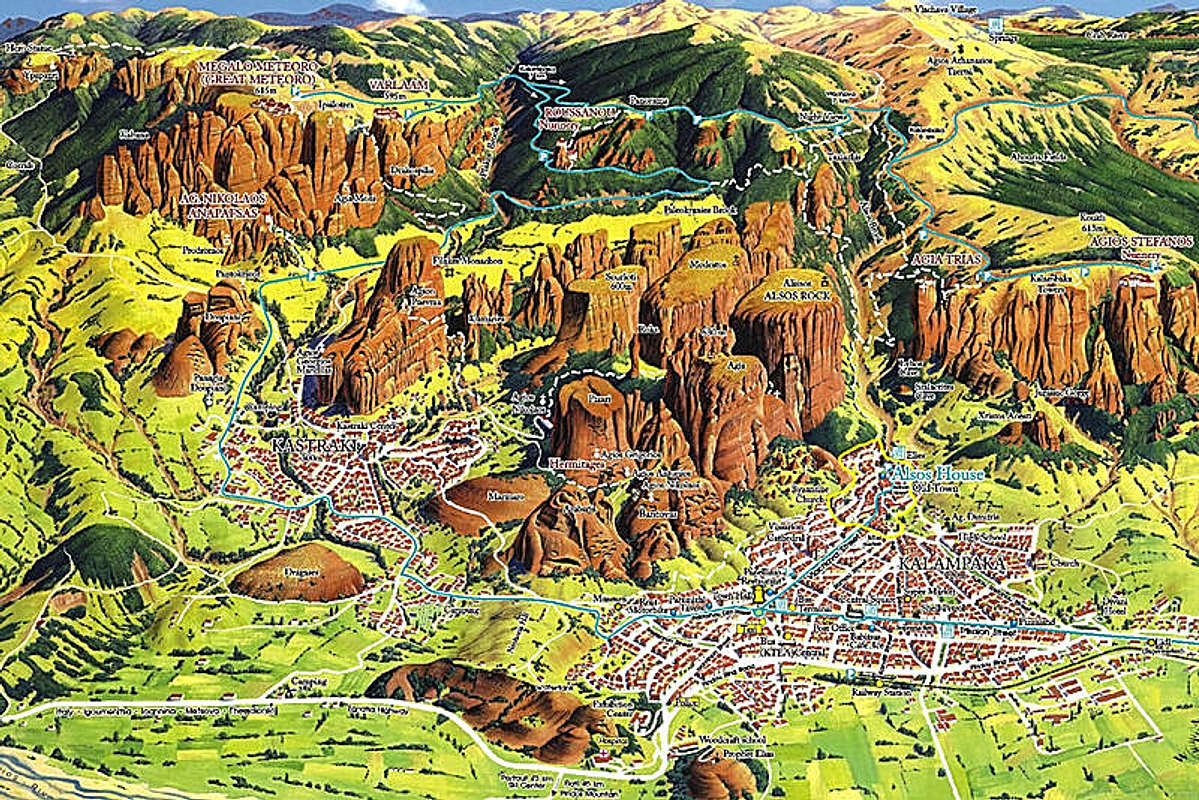-
 12062 Hits
12062 Hits
-
 81.17% Score
81.17% Score
-
 13 Votes
13 Votes
|
|
Route |
|---|---|
|
|
39.72488°N / 21.62247°E |
|
|
Trad Climbing |
|
|
Spring, Fall |
|
|
Half a day |
|
|
VI-, A1 or something like VII, 130m |
|
|
5 |
|
|
Overview
Kelch is a mighty and attractive tower located in the Meteora (Μετέωρα) area, whose meaning is literally "hanging in the air", a charming and suggestive climbing site located in the Thessaly region of Greece. Kelch belongs to the Meteora Western Group and it's one of the most characteristic rocks of this sector and definitely also one of the best rock climbing destination here in Meteora. Kelch has an unmistakable appearance with its characteristic huge boulder "balancing" on the top, creating a big gap/chimney with the lower summit.
This gap is the point of the most famous bridging of Meteora. Almost everybody manages it on aid, because it needs to be tall and strong to make it all free.
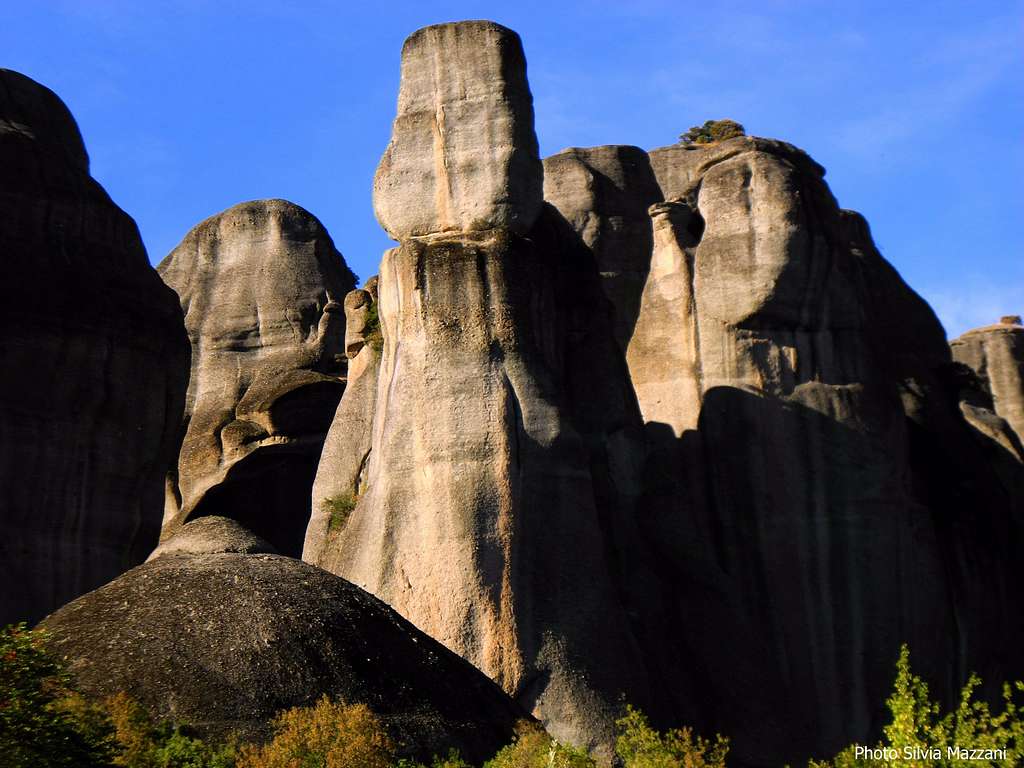
Kelch means something like "Cup" in English and is called "Diskopotiro" in Greek, which means the same think. It is well known that the developement of Meteora was done mainly by East Germany climbers. The 2 guidebooks that include the most of the routes (except some new ones) were created by D. Hasse and H.L. Stutte, mainly in german language, with some greek and english also. So all the rock formation in Meteora have two names, the original Greek one plus the German one created by the first climbers. In recent times the English name which is the translation of the first two names and is more convenient for the climbers who doesn't speak German or Greek is frequently used. Anyway it does not respect the original nomenclature, so it is better to keep some names as they appear in the guidebooks, rather than translate them in english. I think it's easier for somebody who wants to visit the place.
Eiertanz means "Dance of eggs" in English and was climbed first by Heinz Lothar Stutte and Otto Scheda in 15.4.1982. That's for the 4 first pitches. The last pitch is part of Nordweg (North Route), which FA by Dietrich Hasse and Sepp Eichinger in 20.8.1975. Nordweg was the FA of the Kelch as well.
Getting There
For getting to Meteora, check the Meteora page.
Once in Kastraki village you can walk from the square to the West Group in 10-15 minutes, or you can park your car near the Doupiani Rock. From Doupiani to Kelch is a 5 minutes walk.
Route Description
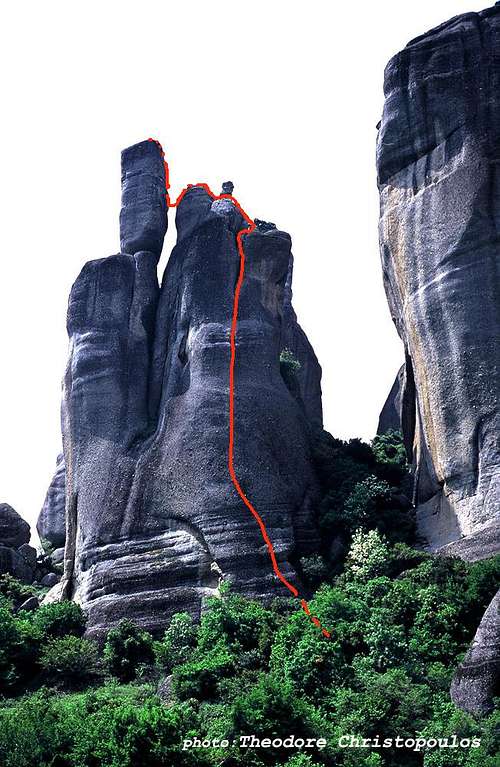
Eiertanz (Dance of Eggs) on Kelch is one of the most popular routes in Meteora.
Although it's a relative "easy" route, it needs a serious approach, because of the kind of the climbing: quite runout and an entertaining final down-climb and bridge across the void. The route begins on the East side of the Kelch, right of a big loose cave/overhang.
L1 - Start direct to the first ring, or avoid first meters from the right through easier ground. Pay attention until the first ring, the rock is a little loose. Pass a small vertical step (V). Climb straight up and a little to the left. When you'll feel uncomfortable high of the first ring, look to the left for the second one. Don't go to the 3rd ring visible higher, even though it's easy (IV). Second ring is a few meters left of the 'normal' logic line, in a small cavity, and not very visible. Belay on the big (16mm) ring. 25m, 3 bolts.
L2 - Climb straigt up, face climbing (V- to V) that becomes more difficult as you go higher, with more bolts though. Some well protected, vertical meters (VI-) with big stones, that leads to 'ledge' with belay-2 rings. 25m, 7 bolts. You can climb these 2 pitches with 60m ropes.
L3 - Slab climbing on friction (V,not enough/small stones) to bolt and straight up to the chimney, you can place a sling to the 'tree'. Climb the dihedral/chimney (IV) until it stops by an overhang, go left to the groove which leads to the belay (one ring to the right). 40m, becarefull about rope friction, 1 bolt plus nuts/cams.
L4 - Easy (III) slab all the way to the lower top. Look out the loose rock near the top. 20m, no bolts of course.
You can descent from here to the deck with 2 rappels following the Nordweg (North route). 1x30m (don't use the summit ring, there is another one for rappeling) to the jammed block/ledge and 1x40m to the ground.
L4 - If you decide to climb to the main summit of Kelch you have to downclimb to the gap, using the slings being there permanentely. Always think about the second(s) because this part is more exposed for him/them. Grab the sling with left hand and clip another sling to the other side. Guidebook gives that you need aiders, but I think that it's Ok without. Just a little more pump. Step to the other side, traverse to the left, until the crack. Follow the crack to the very top. Some people climb this pitch using only the fixed bolts, some others (like me) use 1-2 trad runners. The guidebook gives the whole pitch A1, V. If you do only the crossing on aid, the rest free climbing feels like VI-/VI. About free climbing/stemming/bridging/ jumping/...the whole think, ask the locals. 20m, 7 bolts.
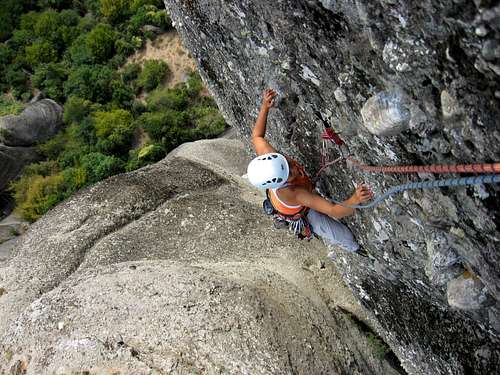
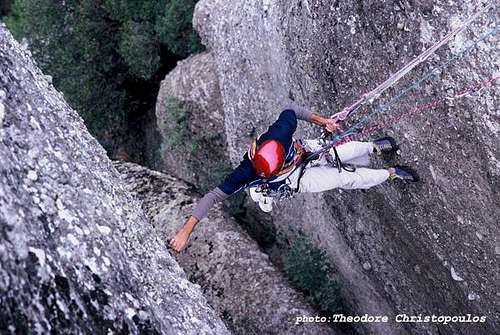
For the descent there are 2 options:
-West side, the classic descent with the famous classic rope jams, to the Spiralweg (Spiral route). 1x35m to the tree inside the big chimney/gap, 1x15m from the tree to the ring right on ledge with tree, then 1x30m to the ground. Some people do 1x45m (first two in one) to first belay of Spiralweg, and then 1x30m to the ground. Look out for the knot, lower it as much as possible. Look out for the trees...
-East side, new wave abseiling by Gustl. 1x50+!!!m (includes the rope streching), to bolts in nowhere, then another 1x45m open air rappel to the ground. Brrrrrr!
Something very important for abseiling in Meteora is the way of putting the knot through the 'horizontal' rings. You have to put the rope with the knot (the rope for the pull) on the downside of the ring (between the ring and the rock). Otherwise maybe there is a problem, because the pulling rope is blocking the other rope, pressing it with the ring to the rock.
The time for the whole route with descent is about 2:00 to 4:30 for the most parties. The rock quality in Eiertanz is generally good, except some loose rock reported on the description. The route has hundreds of repeats. ENJOY!
Essential Gear
For this route you need: 2x50m half/twin ropes, helmet, personal gear (harness, lockers, belay/rappel device, climbing shoes), slings and 8-10 quickdraws, some medium/large nuts, 2 medium cams or hexes.
Red Tape
No fees no permits and no restriction to climb on Kelch.
When to climb
Spring and Autumn are the best seasons for Meteora. Avoid Summer, especially really hot days. Eiertanz is a good choice for winter mornings, in fact it's East facing in general, but the last pitch looks North. The route has sun until noon (more or less, depending on the season).
Accomodation
There is a great number of hotel rooms, B&Bs and rooms to rent in the village of Kastraki, the village built in the shadow of the Meteora towers. The nearby town of Kalabaka also features many accomodation choices. There are also three organized campsites, amongst which the nearest one to the crags is Camping Vrachos in Kastraki. There is also a smaller campsite near the tower of Doupiani. There are plenty of eating out options, particularly tasty traditional Greek food and pizzerias, both in Kastraki and Kalambaka.
Meteo
Guidebooks

“Meteora – Climbing and hiking” by Dietrich Hasse and Heinz Lothar Stutte - I edition 1986, in English and German. It contains around 230 routes. Also, it provides general information about mountaineering, hiking in Meteora, maps, directions.
The second guidebook is:

“Meteora Climbing Part II” by the same Heinz Lothar Stutte and Dietrich Hasse – II edition 2000 – German, Greek and English - Note: the II edition is not a complete guidebook, but an update to the I edition
The Meteora guidebooks can be purchased in Kastraki, Taverna Paradisos or Camping Vrachos. There is also a useful map by the same authors that can be purchased in local shops in Kastraki.
Map
